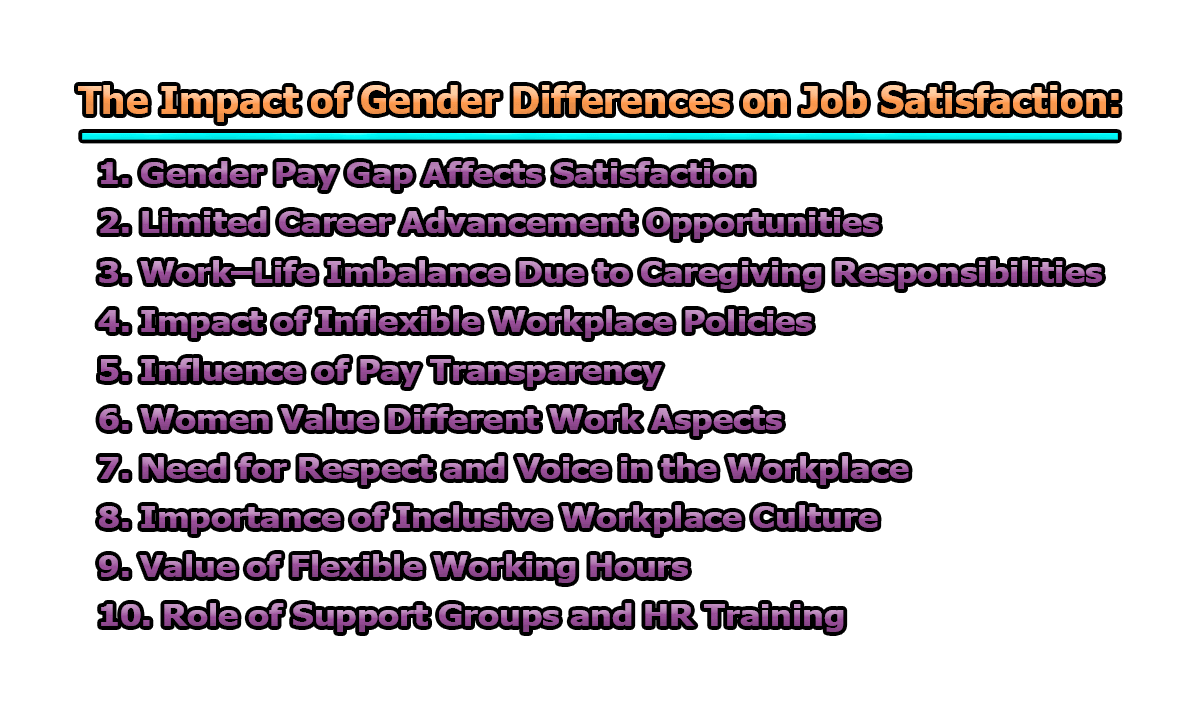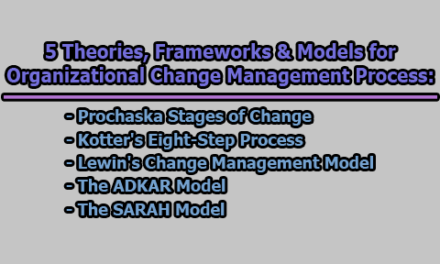The Impact of Gender Differences on Job Satisfaction:
Gender plays a significant role in shaping how individuals experience and evaluate their work environments. Despite growing awareness of workplace equality, women often report lower levels of job satisfaction compared to men. Factors such as the gender pay gap, limited advancement opportunities, inflexible work policies, and unequal recognition contribute to this disparity. Understanding these gender-specific challenges is essential for creating inclusive and supportive workplaces that foster satisfaction for all employees. In this article, we will explore the impact of gender differences on job satisfaction.
1. Gender Pay Gap Affects Satisfaction: The gender pay gap is one of the most visible and persistent forms of workplace inequality. Despite progress in labor rights and equal opportunity legislation, women globally continue to earn less than men for the same or similar work. This wage disparity directly impacts how satisfied women feel in their jobs because salary is not only a source of financial security but also a symbol of recognition and fairness.
A lower salary can make women feel that their efforts and expertise are undervalued by their employer. The lack of parity in earnings becomes especially demoralizing when female employees perform as well as, or better than, their male counterparts. Over time, these feelings of being undercompensated contribute to decreased motivation, productivity, and overall job engagement.
Example: A female marketing manager with five years of experience discovers that her male colleague, hired with the same title and fewer years of experience, is earning 20% more. Though she brings in higher client revenue and has better performance reviews, she is told that “salary structures are confidential.” This leaves her feeling frustrated, unappreciated, and demoralized, affecting her performance and job satisfaction.
Organizational Consequences: Organizations that do not address pay disparities often experience higher turnover rates among women, reduced morale, and reputational damage. Moreover, companies may lose out on top talent who seek workplaces that value fairness and transparency.
Emily (2024) notes that the gender pay gap is a key factor behind women’s lower job satisfaction, as it erodes the sense of being equally rewarded and respected in the workplace.
2. Limited Career Advancement Opportunities: Beyond salaries, many women encounter structural and cultural barriers that limit their opportunities for upward mobility. These barriers—often referred to as the “glass ceiling”—manifest in various forms, including gender bias in promotions, lack of access to high-visibility projects, absence of mentorship, and stereotypical assumptions about leadership capabilities.
Women are often underrepresented in executive and leadership roles across industries, even when they make up a large percentage of the workforce. Research suggests that promotion criteria may unintentionally favor traits traditionally associated with male leadership styles, such as assertiveness or dominance, while undervaluing collaboration and emotional intelligence—traits where women often excel.
Example: A woman in a financial firm consistently exceeds her sales targets, leads her team effectively, and demonstrates strong leadership potential. However, when a senior management position opens, a less-experienced male colleague is promoted. Management justifies the decision by stating he “has the right presence” for leadership. This decision reinforces the perception that promotions are biased, not based on merit, which discourages the woman from striving for higher positions.
Long-Term Effects: This lack of advancement leads to stagnation in women’s careers and contributes to lower levels of satisfaction and commitment. It also creates a culture where women feel invisible or excluded from decision-making processes, which further exacerbates feelings of inequality and disempowerment.
According to Colquitt (2001), perceived organizational injustice—such as being unfairly passed over for promotion—significantly diminishes employee satisfaction, especially among those already facing systemic barriers.
3. Work–Life Imbalance Due to Caregiving Responsibilities: Work–life balance is a critical component of job satisfaction, and it is an area where gender differences are most pronounced. Societal expectations often place the majority of caregiving duties—such as raising children, managing household tasks, or caring for elderly family members—on women. As a result, women frequently face conflicting demands between their work roles and family responsibilities.
When workplaces are inflexible—offering rigid schedules, long hours, or minimal leave—it becomes extremely difficult for women to manage both domains effectively. This leads to stress, burnout, and a diminished ability to perform at work, all of which contribute to lower job satisfaction. Moreover, women who need accommodations (e.g., part-time hours or remote work) are often unfairly penalized or seen as less committed.
Example: A female project coordinator with two young children requests to adjust her hours slightly to align with school drop-off and pick-up times. Her manager denies the request, claiming it would “disrupt team cohesion,” even though several male colleagues have been allowed flexible arrangements. As a result, she struggles to meet both work and family obligations, feels unsupported, and begins to disengage from her job.
Wider Implications: Women in such situations may choose to reduce their working hours, switch to less demanding roles, or leave the workforce altogether. This not only affects their career progression and financial independence but also deprives organizations of skilled and experienced professionals.
Cerrato and Cifre (2018) emphasize the disproportionate impact of inflexible workplace policies on women, while Sharma (2021) supports the claim that the inability to achieve work–life balance is a significant factor in female job dissatisfaction.
4. Impact of Inflexible Workplace Policies: Rigid workplace structures—such as fixed working hours, strict attendance policies, or limited remote work options—disproportionately affect women, especially those who bear additional responsibilities at home. Inflexibility can prevent women from fully participating in the workforce or cause them to experience chronic stress from trying to meet competing demands.
While inflexible policies may appear neutral, they often ignore the reality that many employees, particularly women, are managing caregiving roles alongside their professional duties. Lack of autonomy in how and when work is done creates an environment where women feel their personal needs are not recognized or accommodated. Over time, this leads to lower satisfaction, increased absenteeism, and even attrition.
Example: A woman employed as a customer service supervisor must be present on-site from 9 a.m. to 6 p.m. daily. She asks to leave 30 minutes early twice a week to care for her disabled parent, offering to make up the time remotely. Her request is denied with the explanation that “everyone must be treated the same.” The policy’s rigidity causes her daily anxiety and contributes to her dissatisfaction with the job.
Organizational Costs: Inflexible policies can result in high turnover among women, increased stress-related sick leaves, and a reduced talent pool. Companies that fail to modernize their work policies risk alienating not just women, but all employees seeking greater work-life integration.
Sharma (2021) stresses that workplace inflexibility is one of the most significant contributors to women’s job dissatisfaction, especially for those balancing professional and domestic responsibilities.
5. Influence of Pay Transparency: Pay transparency—the open sharing of compensation information and structures—has been found to significantly increase employee trust and satisfaction. It allows workers to understand how pay decisions are made and whether they are being compensated fairly. For women, who are often unaware of existing wage gaps, transparency can be empowering and help correct pay inequalities.
Without access to salary benchmarks or clarity on pay scales, many women remain unaware that they are underpaid compared to male peers. This hidden disparity breeds quiet resentment and disengagement. However, when companies implement transparent policies, it fosters a sense of fairness and accountability, which improves trust and satisfaction among employees.
Example: In a company that publicly posts salary bands for every job title, a female employee discovers that she is at the lower end of the band despite strong performance. She brings this to HR’s attention and is given a performance-based raise. Knowing her value is recognized, she feels more satisfied and committed to the organization.
Organizational Benefits: Transparent pay structures reduce the likelihood of discrimination, improve employee morale, and create a culture of openness. It also places pressure on organizations to ensure their compensation practices are fair and equitable.
Bamberger and Belogolovsky (2017) found that pay transparency leads to higher levels of job satisfaction and trust in management, particularly among women and other underrepresented groups.
6. Women Value Different Work Aspects: Gender differences in job satisfaction are also influenced by what men and women prioritize in their work. While men may often focus on income and status, women tend to value relational and meaningful aspects of their roles—such as positive team dynamics, job security, emotional fulfillment, and opportunities to contribute to a greater purpose.
Women are more likely to report satisfaction when their job aligns with their personal values, offers autonomy, and provides a respectful, supportive environment. This doesn’t mean financial rewards are unimportant—but for many women, intangible factors such as purpose, collegial support, and emotional well-being weigh just as heavily in how satisfied they feel at work.
Example: A woman working as a healthcare administrator finds great satisfaction in knowing her work supports patient care and community wellness. She earns less than her peers in the corporate sector but reports high job satisfaction because the job aligns with her values and offers respectful, people-focused leadership.
Strategic Implications for Employers: To retain female talent, organizations should go beyond financial compensation and offer a supportive work culture, meaningful tasks, and opportunities for professional growth that align with diverse priorities.
McGuinness and Redmond (2020) argue that women’s job satisfaction is shaped by different criteria than men’s, with a stronger emphasis on work-life balance, respect, and interpersonal relationships.
7. Need for Respect and Voice in the Workplace: Feeling respected and having a voice are fundamental human needs that deeply influence job satisfaction—especially for women, who have historically been marginalized in many professional environments. When women are heard, their contributions acknowledged, and their perspectives considered in decision-making, they are more likely to feel valued and engaged at work.
Respect in the workplace goes beyond politeness—it includes being treated as a competent professional, having one’s opinions taken seriously, and being included in critical discussions. When women are talked over, dismissed, or excluded from key conversations, it not only damages their self-esteem but also undermines their trust in the organization.
Example: During team meetings, a female project lead repeatedly finds her suggestions overlooked until echoed by a male colleague. Over time, she becomes less willing to speak up and feels increasingly invisible, even though her performance is strong. This lack of acknowledgment erodes her satisfaction and commitment to the team.
Organizational Insight: Respectful and inclusive environments contribute to greater psychological safety, where employees of all genders feel free to share ideas, voice concerns, and participate fully. When women feel respected and heard, their engagement, innovation, and job satisfaction significantly increase.
Duda (2014) emphasizes that inclusion, recognition, and respect are not luxuries but fundamental components of employee satisfaction and long-term organizational success.
8. Importance of Inclusive Workplace Culture: An inclusive workplace culture is one where diversity is not only accepted but celebrated, and where all employees—regardless of gender—have equal access to resources, opportunities, and support. Such cultures promote equity, reduce bias, and foster a sense of belonging, all of which are essential for job satisfaction among women.
Women in non-inclusive environments may feel isolated, unsupported, or subject to microaggressions. Conversely, inclusive cultures recognize diverse needs and actively work to eliminate systemic barriers. They create spaces where women are empowered to grow and succeed without needing to conform to male-dominated norms.
Example: In an inclusive tech company, female developers are mentored by senior women, involved in product strategy meetings, and supported in returning to work after maternity leave. These initiatives help women feel seen, respected, and aligned with the company’s values—leading to higher job satisfaction.
Why It Matters: A culture that visibly supports gender equity increases retention, reduces stress, and enhances the sense of professional identity among women. It also signals that the organization values everyone’s contributions equally.
Duda (2014) identifies inclusive organizational culture as a foundational factor that enables women to flourish in the workplace and achieve long-term satisfaction.
9. Value of Flexible Working Hours: Flexibility is not just a convenience—it’s a necessity for many women who navigate dual roles at work and home. Flexible work arrangements, such as flextime, remote work, or compressed workweeks, are strongly linked to higher job satisfaction, especially for women managing caregiving duties or health-related needs.
Without flexible options, women often face impossible choices between their personal responsibilities and professional ambitions. Flexibility allows them to meet their obligations without sacrificing career growth, reducing burnout and increasing loyalty to the organization.
Example: A female data analyst who is also the primary caregiver for her child is allowed to start her workday at 10 a.m. and work from home two days a week. This flexibility helps her manage school drop-offs and medical appointments, which reduces stress and improves her job performance and satisfaction.
Organizational Outcomes: Flexible work policies are not only beneficial to employees—they’re also good for business. Companies that adopt them report higher employee retention, reduced absenteeism, and a more engaged workforce.
Banerjee et al. (2024) confirm that flexible working hours are highly valued by women, particularly those balancing work with caregiving or domestic roles, and directly contribute to increased job satisfaction.
10. Role of Support Groups and HR Training: Support structures such as employee resource groups (ERGs), mentorship programs, and trained human resource (HR) personnel play a vital role in fostering job satisfaction among women. These systems provide safe spaces to discuss challenges, share experiences, and advocate for necessary changes within the organization.
Women who feel isolated in male-dominated industries often benefit from structured communities where they can connect with others who understand their experiences. Additionally, HR departments that are trained in gender sensitivity can better respond to issues like harassment, bias, or discrimination, making women feel safer and more supported.
Example: At a large university, a women-in-leadership group provides monthly networking events, mentorship from senior staff, and leadership workshops. A junior faculty member credits the group with helping her build confidence and navigate career decisions, which improves her job satisfaction and long-term commitment to the institution.
Strategic Impact: Support networks and HR training don’t just benefit individuals—they create a ripple effect across the workplace, fostering a culture where women feel seen, supported, and empowered to thrive.
Floyd & Martin (2023) highlight the significance of peer support networks in improving women’s sense of belonging, while Ridgeway (2015) emphasizes the need for trained HR personnel to ensure workplace fairness and gender equity.
It is apparent that gender differences in job satisfaction are influenced by a complex mix of structural, cultural, and personal factors. Addressing issues such as unequal pay, lack of flexibility, and underrepresentation in leadership can significantly enhance job satisfaction among women. By promoting fairness, inclusion, and support, organizations not only empower women but also improve overall employee engagement, retention, and performance.
Frequently Asked Questions (FAQs):
Why do gender differences matter in job satisfaction studies?
Gender differences highlight how men and women may experience the workplace differently due to societal roles, expectations, and systemic inequalities. Understanding these differences helps organizations create more equitable and satisfying work environments for all employees.
What is the main cause of lower job satisfaction among women?
Key factors include the gender pay gap, limited opportunities for career advancement, lack of flexibility, and feeling undervalued or unheard in the workplace. These issues collectively lead to lower engagement and satisfaction levels among many women.
How does the gender pay gap affect women’s job satisfaction?
When women are paid less than their male counterparts for similar work, it creates a perception of unfairness and inequality. This leads to decreased motivation, trust, and satisfaction in their roles.
Are flexible work policies more important to women than men?
Flexible work policies benefit all employees, but they are especially important for women, who are more likely to manage caregiving responsibilities. Flexibility can significantly enhance women’s ability to balance personal and professional life, leading to higher satisfaction.
How can companies improve job satisfaction among female employees?
Organizations can take several steps, including promoting pay transparency, offering flexible working hours, supporting women’s career growth, fostering inclusive cultures, and providing access to mentorship and support groups.
Do women value different aspects of work compared to men?
Yes, research suggests that women often prioritize relational, meaningful, and supportive aspects of work—such as respect, work-life balance, and team collaboration—more than financial rewards or status alone.
Can inclusive workplace cultures really improve job satisfaction for women?
Absolutely. Inclusive cultures that respect diversity and promote equality empower women to participate fully, feel respected, and thrive in their roles, which significantly boosts satisfaction and retention.
What role does HR play in supporting women’s job satisfaction?
Trained HR personnel can ensure fair treatment, resolve conflicts, address complaints effectively, and implement policies that support gender equity, making a critical difference in how women experience the workplace.
Is job satisfaction only a women’s issue?
No, job satisfaction affects everyone, but addressing the gender-specific challenges women face is crucial for ensuring equity. Enhancing satisfaction for women ultimately improves the workplace for all employees.
How can I implement these insights in my own workplace?
Start by conducting pay audits, encouraging feedback from female staff, reviewing promotion practices, and introducing flexible schedules. Establishing support networks and inclusive training also creates a more satisfying and equitable work environment.
References:
- Bamberger, P. A., & Belogolovsky, E. (2017). The dark side of transparency: How and when pay administration practices affect employee helping. Journal of Applied Psychology, 102(4), 658–671. https://doi.org/10.1037/apl0000184
- Banerjee, R., Bharati, T., Fakir, A. M. S., Qian, Y., & Sunder, N. (2024). Gender differences in preferences for flexible work hours: Experimental evidence from an online freelancing platform (IZA Discussion Paper No. 17434). IZA – Institute of Labor Economics. https://www.econstor.eu/bitstream/10419/308293/1/dp17434.pdf
- Cerrato, J., & Cifre, E. (2018). Gender inequality in household chores and work-family conflict. Frontiers in Psychology, 9, Article 1330. https://doi.org/10.3389/fpsyg.2018.01330
- Colquitt, J. A. (2001). On the dimensionality of organizational justice: A construct validation of a measure. Journal of Applied Psychology, 86(3), 386–400. https://doi.org/10.1037/0021-9010.86.3.386
- Duda, R. (2014). 80,000 Hours. Retrieved April 6, 2025, from https://80000hours.org/articles/job-satisfaction-research/
- Emily, C. (2024). Impact of gender pay gap on workplace productivity and employee morale in Canada. International Journal of Sociology, 8(3), 24–35. https://doi.org/10.47604/ijs.2831
- Floyd, J., & Martin, K. (2023). Employee Resource Groups (ERG): An embedded resource. University of Oklahoma. Employee Resource Groups (ERG)
- McGuinness, S., & Redmond, P. (2020). Explaining the gender gap in job satisfaction. Applied Economics Letters, 27(17), 1415–1418. https://doi.org/10.1080/13504851.2019.1686111
- Sharma, N. (2021). Systematic review of work-life balance on gender: Variables and avenues for future research. International Journal of Creative Research Thoughts, 9(11), 496–503.

Library Lecturer at Nurul Amin Degree College










